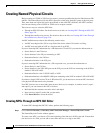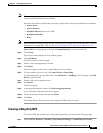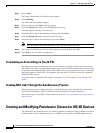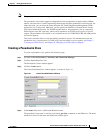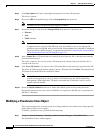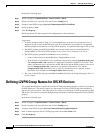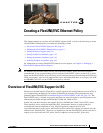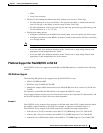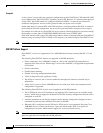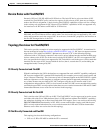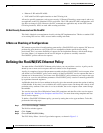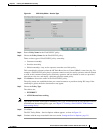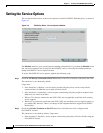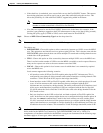
3-2
Cisco IP Solution Center L2VPN and Carrier Ethernet User Guide, 6.0
OL-21636-01
Chapter 3 Creating a FlexUNI/EVC Ethernet Policy
Overview of FlexUNI/EVC Support in ISC
Services leveraging the FlexUNI/EVC infrastructure are varied in nature, and there is not always a clear
delineation between different services. This is because FlexUNI/EVC provides great flexibility in the
way these services can be delivered. This can make it challenging to define the services. For example, a
traditional ERS could be delivered in several ways by variations of the Class on the platform.
The FlexUNI/EVC policy and associated service request offer a generic and flexible service construct to
support device capabilities. This policy is flexible enough to cater to different service offerings using the
EVC architecture. It allows service designers to utilize most of the EVC features in a flexible manner,
to match the hardware and platform capabilities.
The FlexUNI/EVC policy can be used to create only a FlexUNI/EVC service request and not any other
existing ISC service request types, such as L2VPN, VPLS, and so on. Likewise, a FlexUNI/EVC service
request can be created using only a FlexUNI/EVC policy and not any other existing ISC policies.
The FlexUNI/EVC infrastructure provides several benefits to Carrier Ethernet (CE) deployments,
including:
• Flexible frame matching.
• Flexible VLAN tag manipulation and/or translation.
• Multiple services on the same port.
• Flexible service mapping.
• VLAN scaling and locally significant VLANs.
FlexUNI/EVC supports a variety of network configurations, such as the following:
• Provisioning of Ethernet access as a EVC-capable EWS interface on the N-PE.
• Interconnecting Ethernet accesses terminating on a single Cisco 7600 N-PE on one or multiple ports
in a bridge domain.
• Interconnecting Ethernet accesses terminating on multiple Cisco 7600 N-PEs in a VPLS service.
• FlexUNI/EVC service support on Cisco ASR 9000 Series Routers running IOS XR.
• Services that combine the existing services with the Ethernet access, including the ERS/EWS
interworking service.
• Provisioning of E-Line services, in which one or both N-PE interfaces are FlexUNI.
FlexUNI/EVC Features
This section summarizes the features supported by the FlexUNI/EVC policy and service request in ISC:
• Choice of topology:
–
Customer edge device (CE) directly connected.
–
CE connected through Ethernet access devices.
• Choice of platforms:
–
FlexUNI/EVC on all N-PEs.
–
FlexUNI/EVC on none of the N-PEs.
–
Mix of FlexUNI/EVC and the old infrastructure. This allows both the old and new platforms to
co-exist, in order to ensure continued support for deployed platforms.
• Choice of connectivity across the MPLS core (with or without bridge-domain):
–
Pseudo wires



